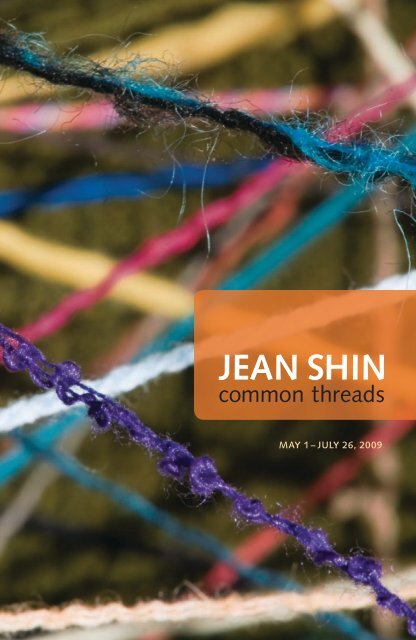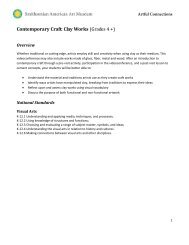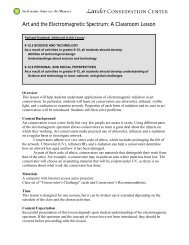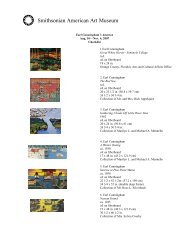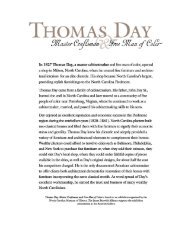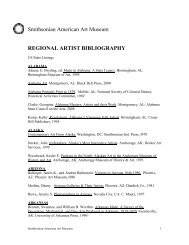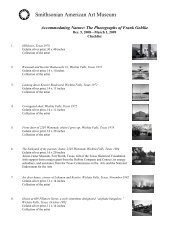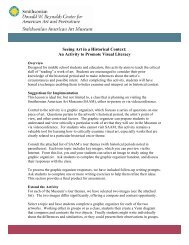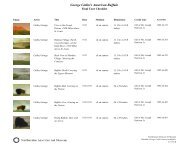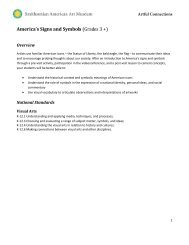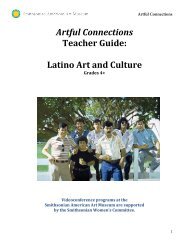JEAN SHIN - Smithsonian American Art Museum
JEAN SHIN - Smithsonian American Art Museum
JEAN SHIN - Smithsonian American Art Museum
Create successful ePaper yourself
Turn your PDF publications into a flip-book with our unique Google optimized e-Paper software.
jean shin<br />
common threads<br />
May 1 – July 26, 2009
jean shin<br />
common threads<br />
Jean Shin has gained national recognition<br />
for her transformative installations that give new life to<br />
the castoff items of consumer society. Her inventory of<br />
scavenged and obsolete materials includes worn shoes,<br />
lost socks, broken umbrellas, discarded lottery tickets,<br />
and prescription pill bottles, all of which she accumulates<br />
in massive quantities. Shin then transmutes her humble finds through<br />
a meticulous process of deconstruction, alteration, and restoration. The<br />
resulting sculptures and installations consist of hundreds, sometimes<br />
thousands, of seemingly identical objects, each of which carries a multitude<br />
of potential meanings that inspire both personal and collective<br />
associations. The effect is both seductive and arresting. The pieces are<br />
at once rigorously formal and emotionally resonant, mass-produced yet<br />
insistently handmade. They reference a wide range of art historical precedents,<br />
from minimalism, with its unyielding repetition of singular forms,<br />
to feminism, with its focus on traditional craft techniques, and <strong>Art</strong>e<br />
Povera, with its connection to everyday life.<br />
Shin is equally indebted to the legacy of twentieth-century assemblage<br />
art, in particular the experiments of Louise Nevelson, whose dense<br />
arrangements of scavenged objects possess a striking visual unity, but<br />
also emphasize the astonishing variety of constituent parts. This duality<br />
Untied<br />
as installed at Exit <strong>Art</strong>,<br />
New York, 2000<br />
is a signature feature of Shin’s work, as is her exuberant use of color.<br />
Shin, however, departs from her predecessors by expanding assemblage<br />
into the realm of the participatory. She not only focuses on the power of<br />
the objects themselves but also their relationship to the environment and<br />
the viewer. This emphasis on the actual circumstances in which one<br />
encounters a work of art—the space of lived experience—recalls the work<br />
of postminimalist artists, such as Eva Hesse and Félix González-Torres,<br />
who championed a type of sculptural viewing predicated on process, participation,<br />
and the body. The notion of an embodied viewing is elegantly<br />
articulated in Shin’s “site-responsive” sculptures and installations, which<br />
draw the viewer into a close visual and physical encounter.<br />
The body is a central metaphor in Shin’s work, born from her study<br />
of anatomy, life drawing, and figurative painting at the Pratt Institute, and<br />
expanded at the Skowhegan School of Painting and Sculpture. She frequently<br />
gathers material from friends, relatives, colleagues, and community<br />
members. The donated items serve as surrogates for their original owners<br />
by referencing the body both physically and metaphorically. This relationship<br />
is particularly evident in Shin’s early work, comprising clothing and<br />
related accessories.<br />
One such work, Untied (2000), consists of hundreds of thrift-store<br />
neckties cascading over a freestanding chain-link fence. Shin first showed<br />
the work on a city street in New Haven, Connecticut, under the title Fringe<br />
(2000). The installation was subsequently adapted for gallery exhibition.<br />
In both versions, the neckties are knotted row upon row in a spectrum of<br />
colors and patterns; however, their interpretations differ markedly. The<br />
installation of Fringe was presented along a twenty-foot stretch of fence<br />
on the edge of a vacant lot owned by area real-estate developers. Shin<br />
fashioned the silky array as a commentary on the radical divide between<br />
wealth and poverty in the city. Unexpectedly, pedestrians waiting at the<br />
nearby bus stop began taking ownership of the ties, literally and figuratively.<br />
Some were taken for personal use—job interviews and Sunday<br />
church services—while the remaining ties were pulled through the mesh<br />
barrier to face the street rather than the vacant lot. This process of reclamation<br />
became a powerful gesture of optimism and transcendence, as the<br />
community attempted to better its sartorial and municipal appearance.<br />
Not surprisingly, when the installation is removed (or untied) from its urban<br />
environment and presented in a gallery setting, the connotations change.<br />
The fence no longer acts as a impassable barrier separating property and<br />
people as it did in New Haven. In the gallery, visitors can circumnavigate<br />
the installation, literally viewing it from “both sides of the fence.”<br />
Chance City (2001/2009) also comments on the experience of<br />
urban life. The project was first installed at <strong>Art</strong> in General in New York,<br />
and since then has been exhibited in a variety of different locations and<br />
configurations. The work comprises thousands of discarded instant lottery<br />
tickets, which Shin collected in New York City and Washington, D.C.,
Chance City<br />
as installed at the Brooklyn<br />
<strong>Museum</strong>, New York, 2004.<br />
Photograph by Masahiro<br />
Noguchi<br />
over three years. Each ticket is painstakingly balanced on top of the other<br />
to create a sprawling city of cards without any supplementary support.<br />
The inevitable collapse of Shin’s structure serves as a metaphor for the<br />
lottery ticket’s illusory promise of fast cash and the inherent vulnerability<br />
of a society built on the precarious pillars of money and chance. However,<br />
despite the overwhelming sense of failure generated by thousands of losing<br />
lottery tickets, Chance City reverberates with a palpable sense of optimism.<br />
Although the materials for Fringe/Untied and Chance City were<br />
amassed from anonymous donors, the idea of community engagement<br />
played a significant role in the conception of these early projects.<br />
Recently the practice of soliciting donations from a specific group has<br />
become increasingly important, as she cites here: “The process of accumulating<br />
hundreds of a particular discarded object for my installations<br />
becomes an informal survey that reflects our identity as a society—<br />
ultimately creating a ‘collective portrait’ of our immediate community.” 1<br />
This aspect of collaboration is an integral part of Shin’s process, and<br />
many of her recent projects emerge from a close dialogue with a particular<br />
organization.<br />
For Armed (2005/2009), Shin contacted the Harbor Defense<br />
<strong>Museum</strong> at Fort Hamilton, Brooklyn, to identify local servicemen and<br />
women who would be willing to donate their uniforms. Soldiers from the<br />
Armed<br />
as installed at Roebling Hall,<br />
New York, 2005<br />
Army, Navy, Air Force, and Coast Guard all participated in the project to<br />
create a vast mural of <strong>American</strong> military uniforms. The different types of<br />
camouflage reflect the varied landscape in which <strong>American</strong> troops have<br />
historically served, from the jungle to the desert. As in similar works, Shin<br />
disassembled each garment. Seams, cuffs, and collars were removed to<br />
create a canopy, while the larger pieces were starched flat for application<br />
to the wall. The fabric mosaic reflects the regimented culture of military<br />
service, which demands that individual identity be abandoned in favor of<br />
the group. However, each fragment in Armed carries a personal history<br />
of the former owner.<br />
The notion of communal versus individual identity is similarly<br />
articulated in Unraveling (2006–2009). Here again, Shin gives visual<br />
form to a unique population. The sweaters belong to members of the<br />
Asian <strong>American</strong> arts communities in New York, Houston, Berkeley, Los<br />
Angeles, Honolulu, and Washington, D.C., where the piece has been<br />
shown. Shin has painstakingly unraveled the sweaters and connected the<br />
yarns in a brightly colored web that reflects the dynamic social network of<br />
artists, curators, collectors, and dealers, among others. A label bearing the<br />
name of each participant is sewn onto the edge of the owner’s deconstructed<br />
garment. Unraveling is an extraordinary testament to the artist’s<br />
agile hand and tenacious work ethic. Shin attributes her labor-intensive
Unraveling<br />
as installed at Blaffer Gallery,<br />
<strong>Art</strong> <strong>Museum</strong> at the University<br />
of Houston, 2007<br />
practice to the example set by her parents, who immigrated from Seoul,<br />
South Korea, to the suburbs of Maryland in 1978, when Jean was six.<br />
Their emphatic commitment to hard work at the family grocery store<br />
remains a source of pride and inspiration. 2 The experience of stocking<br />
shelves, rearranging inventory, and negotiating with neighborhood customers<br />
has not only informed Shin’s process but also the formal and<br />
conceptual thrust of her work.<br />
Chemical Balance III (2009) deals more directly with the production,<br />
commodification, and consumption of commercial goods. Thousands<br />
of empty prescription pill bottles are stacked into towering arrangements<br />
that resemble natural forms such as stalactites and stalagmites. The installation<br />
speaks to our culture’s overconsumption of prescription drugs and<br />
our dependency on these medications to correct or alter our internal<br />
chemical balance. The containers were collected from nursing homes,<br />
pharmacies, friends, and family of the artist. This new version of Chemical<br />
Balance incorporates lighting elements inside each structure. The addition<br />
of artificial illumination functions as a metaphor for the relief and renewed<br />
optimism that comes from restored health after an illness.<br />
Shin’s intimate reference to the human body in Chemical Balance III<br />
is also evident in TEXTile (2006). Commissioned by the Fabric Workshop<br />
and <strong>Museum</strong> (FWM) in Philadelphia, TEXTile consists of thousands<br />
of discarded computer keys that Shin extracted from keyboards and<br />
re- contextualized. The key caps are attached to a continuous textile,<br />
which, when read from left to right, spells out a line-by-line transcript of<br />
the email correspondence between Shin and the project staff. Thus, the<br />
custom-made keyboard documents the process of its own making during<br />
Shin’s residency at FWM. The first three rows of the textile are “active”<br />
keys on which viewers are invited to type. Their text instantly appears on<br />
the projections at the end of the textile, creating a virtual extension of the<br />
conversation within the key-encrusted cloth. In a surprising twist,<br />
visitors will discover that the traditional QWERTY layout of the keyboard<br />
has been scrambled, forcing them to search for individual letters within<br />
existing words to compose their own text. The work calls attention to<br />
objects that most of us touch every day as a means of communication<br />
between co-workers, friends, and family. For Shin, the act of typing on a<br />
keyboard has a physical immediacy that not only relates to the body but<br />
also to the construction of language in a technology-driven society.<br />
In her newest work, commissioned by the <strong>Smithsonian</strong> <strong>American</strong> <strong>Art</strong><br />
<strong>Museum</strong>, Shin celebrates the unsung heroes of our society whose everyday<br />
labors go unrecognized. Everyday Monuments (2009) grew out of Shin’s<br />
interest in the site of Washington, D.C., as a city planned and built around<br />
monuments “that remind and reassure us of permanence and stability as<br />
they embody our society’s heroic ideals.” 3 Shin chose an equally symbolic,<br />
Chemical Balance II<br />
(detail)<br />
as installed at University <strong>Art</strong><br />
<strong>Museum</strong>, Albany,<br />
New York, 2005<br />
Photograph by Ford Bailey<br />
Following page:<br />
Everyday Monuments<br />
(detail)<br />
Photograph by Rebecca<br />
Curry
N o t e s<br />
everyday object to represent the multitude of occupations in the United<br />
States: the sports trophy. According to the artist: “These modest versions<br />
of public monuments mark our personal achievements as well as our past.<br />
They showcase idealized figures ... however this grandeur fades. ... Like<br />
monuments in ruin, the trophies’ worn surfaces and chipped bases recall<br />
bittersweet memories of glory days now past.” 4<br />
Nearly two thousand trophies were donated by Washington-area<br />
residents and transformed in Shin’s Brooklyn studio to modify idealized<br />
sports poses with the unsensational gestures of everyday tasks. In the completed<br />
installation, the altered trophies are arranged on the gallery floor in<br />
a pattern suggesting the layout of the National Mall. Thus, the hundreds of<br />
shimmering figurines symbolically fill the expanse of Washington’s signature<br />
public space, just like the crowd of millions that gathered to witness the<br />
recent inauguration. Shin explains that “metaphorically the mass of trophies<br />
represents an overall collective desire; while ... the accompanying projections<br />
appear impermanent, fragmented, and vulnerable, thus calling into<br />
question our perception of societal ideals and realities.” 5<br />
Everyday Monuments epitomizes Shin’s art of the past decade. This<br />
stunning evocation of the nation’s capital and the <strong>American</strong> work force<br />
touches on ideas of community, memory, and the body, all recurring themes.<br />
By giving new life and restored purpose to forgotten objects, Shin shows<br />
us that value and beauty can be found in the most unanticipated places.<br />
Joanna Marsh<br />
The James Dicke Curator of Contemporary <strong>Art</strong><br />
1 <br />
Jean Shin, “An Interview<br />
with Jean Shin,” Accumulations,<br />
exhibition brochure,<br />
University <strong>Art</strong> <strong>Museum</strong>,<br />
Albany, New York, 2005.<br />
2 <br />
Brooke Kamin Rapaport,<br />
“Jean Shin’s Accumulations<br />
of Ephemera,” Sculpture,<br />
July/August 2008, 33–34.<br />
3<br />
Megan <br />
Gambino, “Calling<br />
All Trophy Holders,”<br />
Around the Mall: Scenes<br />
and Sightings from the<br />
<strong>Smithsonian</strong> <strong>Museum</strong>s and<br />
Beyond, December 9, 2008,<br />
http://blogs.<br />
smithsonianmag.com/<br />
aroundthemall/2008/12/<br />
calling-all-trophy-holdersartist-wants-yours/<br />
4<br />
Unpublished <br />
Shin interview<br />
via email with Megan<br />
Gambino in preparation for<br />
“Calling All Trophy Holders,”<br />
Around the Mall: Scenes<br />
and Sightings from the<br />
<strong>Smithsonian</strong> <strong>Museum</strong>s and<br />
Beyond, December 9, 2008.<br />
5<br />
Ibid.
works in the exhibition<br />
Untied<br />
2000<br />
neckties knotted on<br />
chain-link fence<br />
Courtesy of the <strong>Art</strong>ist and<br />
the <strong>Art</strong>ist Pension Trust<br />
Chance City<br />
2001/2009<br />
$25,382 worth of discarded<br />
losing lottery tickets<br />
Courtesy of the <strong>Art</strong>ist and<br />
the <strong>Art</strong>ist Pension Trust<br />
Penumbra<br />
2003<br />
single-channel video<br />
with sound, 5 minutes,<br />
13 seconds<br />
Courtesy of the <strong>Art</strong>ist and<br />
Frederieke Taylor Gallery,<br />
New York<br />
Armed<br />
2005/2009<br />
cut fabric (U.S. Military<br />
uniforms), starch, thread<br />
Courtesy of the <strong>Art</strong>ist<br />
and Frederieke Taylor<br />
Gallery, New York<br />
TEXTile<br />
2006<br />
22,528 recycled computer<br />
key caps and 192 custom<br />
key caps, high-performance<br />
laminate fabric and Spectra<br />
Fibers, customized active<br />
keyboard, interactive<br />
software, and painted<br />
aluminum armature<br />
Collection of The Fabric<br />
Workshop and <strong>Museum</strong>,<br />
Philadelphia<br />
Unraveling<br />
2006–2009<br />
sweaters collected from<br />
Asian <strong>American</strong> art<br />
communities in New York,<br />
Houston, Berkeley,<br />
Los Angeles, Honolulu,<br />
and Washington, D.C.<br />
Courtesy of the <strong>Art</strong>ist and<br />
Frederieke Taylor Gallery,<br />
New York<br />
Chemical Balance III<br />
2009<br />
prescription pill bottles,<br />
acrylic mirrors, epoxy,<br />
fluorescent lights<br />
Courtesy of the <strong>Art</strong>ist and<br />
Frederieke Taylor Gallery,<br />
New York<br />
Everyday Monuments<br />
2009<br />
sports trophies, cast and<br />
sculpted resins, digital<br />
projections<br />
Courtesy of the <strong>Art</strong>ist and<br />
Frederieke Taylor Gallery,<br />
New York<br />
<strong>Museum</strong> Hours<br />
11:30 am–7:00 pm<br />
Closed December 25<br />
Information<br />
(202) 633-1000 general<br />
(202) 633-5285 TTY<br />
(202) 633-7970 recorded<br />
Location<br />
8th and F Streets, NW<br />
Washington, D.C.<br />
Metro<br />
Gallery Place–Chinatown<br />
(Red, Yellow, and Green<br />
lines)<br />
Accessibility<br />
Barrier-free access is<br />
available at the G Street<br />
entrance. All areas of<br />
the museum are<br />
served by elevators.<br />
Wheelchairs are available.<br />
Please inquire at the<br />
Information Desk.<br />
Visit us online<br />
<strong>American</strong><strong>Art</strong>.si.edu<br />
The <strong>Smithsonian</strong> <strong>American</strong> <strong>Art</strong> <strong>Museum</strong> wishes to thank the Diane and<br />
Norman Bernstein Foundation, Inc.; Janice Kim and Anthony Otten;<br />
Nion McEvoy; and Nick and Holly Ruffin for their generous support of<br />
the exhibition.<br />
TEXTile (full view<br />
above left; detail above)<br />
as installed at The Fabric<br />
Workshop and <strong>Museum</strong>,<br />
Philadelphia, 2006<br />
Photograph by Aaron Igler<br />
Cover:<br />
Unraveling (detail)<br />
Photograph by Seong Kwon


